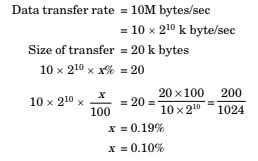Computer System Architecture - Pipeline and Vector Processing
A hard disk has 63 sectors per track, 10 platters each with 2 recording surfaces and 1000 cylinders. The address of a sector is given as a triple (c, h, s), where c is the cylinder number, h is the surface number and s is the sector number. Thus, the 0th sector is addressed as (0, 0, 0), the 1st sector as (0, 0, 1), and so on.
A hard disk has 63 sectors per track, 10 platters each with 2 recording surfaces and 1000 cylinders. The address of a sector is given as a triple (c, h, s), where c is the cylinder number, h is the surface number and s is the sector number. Thus, the 0th sector is addressed as (0, 0, 0), the 1st sector as (0, 0, 1), and so on.
42. The address of 1039th sector is
- Option : C
- Explanation : For option
(a) sector no. = 0 * 20 * 63 + 15 * 63 + 31 = 976 sector.
(b) Sector no = 0 * 20 * 63 + 16 * 63 + 30 = 1038
(c) Sector no = 0 * 20 * 63 + 16 * 63 + 31 = 1039 sector
Hence answer is (c).
- Option : D
- Explanation : Since starting on disk starts from <1200, 9, 40> so no of sectors left on 9th surface is 24
so, on 9th surface total storage of “12288” B is possible Now, a part from 9th surface, on cylinder no. 1200 only 6 surface is left.
To storage possible on these 6 surface are
= 6 * 26 * 29 → storage on each sector.
ᛎ
= 196608 B
So total on cylinder no. 1200, storage possible
= 196608 + 12288 = 208896 B
So Since file size is 42797 kB and out of which 208896 B are stored on cylinder no. 1200. So we are left only with only 43615232 B.
Since in 1 cylinder, Storage Possible is
= 24 * 26 * 29 B = 524288 B
So we need about
= 43615232B / 524288B
= 83.189 more cylinders.
Hence we’ll need the 1284th Cylinder to completely store the file. C02 after 1283rd cylinder we will left with data which will need 189



